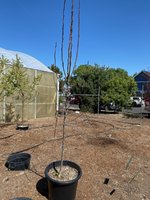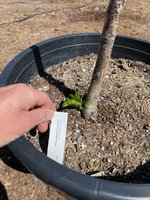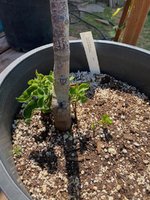I_I_am_not_a_cat
Yamadori
I went to a local nursery and found this Bartlett Pear that was barely alive. I asked if they would sell it to me at a discount and they gave it to me for a $20 pot deposit. I got it home and transplanted it into a mix of the soil it came from and some pumice and pre-made bonsai soil. There was no root ball to speak of and hardly any smaller roots--I wish I had gotten a picture, but somehow missed that.
It has been 3 weeks and the leaves have grown. I kept it under a sun sail that allows for partial shade, but it still gets full early morning and late afternoon/evening sun.
I have not fertilized or done anything other than the trunk chop.
Suggestions appreciated--even if it is to leave it alone other than making sure it does not dry out.
At the nursery:

Here is a closeup of the leaves the day I bought it:

Here is a closeup of the leaves just a couple of days ago:

It has been 3 weeks and the leaves have grown. I kept it under a sun sail that allows for partial shade, but it still gets full early morning and late afternoon/evening sun.
I have not fertilized or done anything other than the trunk chop.
Suggestions appreciated--even if it is to leave it alone other than making sure it does not dry out.
At the nursery:

Here is a closeup of the leaves the day I bought it:

Here is a closeup of the leaves just a couple of days ago:


